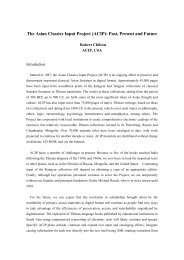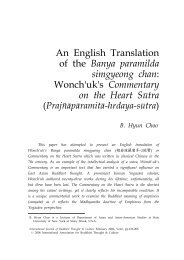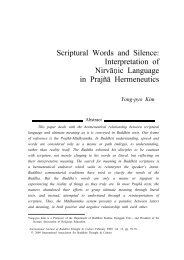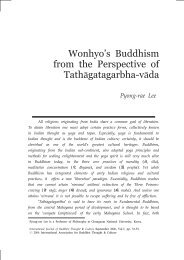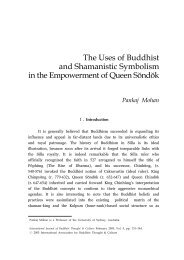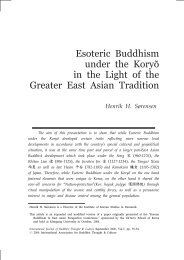The Tibetan Book of the Dead - Buddhism.org
The Tibetan Book of the Dead - Buddhism.org
The Tibetan Book of the Dead - Buddhism.org
You also want an ePaper? Increase the reach of your titles
YUMPU automatically turns print PDFs into web optimized ePapers that Google loves.
<strong>The</strong> <strong>Tibetan</strong> <strong>Book</strong> <strong>of</strong> <strong>the</strong> <strong>Dead</strong><br />
Annie Shapiro 1<br />
<strong>The</strong> <strong>Tibetan</strong> <strong>Book</strong> <strong>of</strong> <strong>the</strong> <strong>Dead</strong> is actually a manual for <strong>the</strong> living. It<br />
details <strong>the</strong> journey each soul must make <strong>of</strong>ter death as reported back by<br />
meditators who used <strong>the</strong>ir lives to journey on o<strong>the</strong>r planes and bring back<br />
information about how reality is constructed. What can we expect after death?<br />
<strong>The</strong> <strong>Tibetan</strong> <strong>Book</strong> <strong>of</strong> <strong>the</strong> <strong>Dead</strong> is a guide for <strong>the</strong> soul, but also is related to<br />
every day life. Once you realize that life and death are not separate, <strong>the</strong>n death<br />
becomes just a continuation <strong>of</strong> <strong>the</strong> journey. Here I have tried my best to<br />
summarize <strong>the</strong> great <strong>Tibetan</strong> classic.<br />
Key words: <strong>The</strong> <strong>Tibetan</strong> <strong>Book</strong> <strong>of</strong> <strong>the</strong> <strong>Dead</strong>, Bardo Thodral,<br />
<strong>Dead</strong>, Tantric <strong>Buddhism</strong>, Tibet.<br />
<strong>The</strong> Bardo Thodral, commonly known as “<strong>The</strong> <strong>Tibetan</strong> <strong>Book</strong> <strong>of</strong> <strong>the</strong><br />
<strong>Dead</strong>” or “Great Liberation by Hearing in <strong>the</strong> Intermediate States,” is a text<br />
<strong>of</strong> spiritual magnitude. According to tradition, it was conceived in <strong>the</strong> 8th<br />
century by <strong>the</strong> <strong>Tibetan</strong> hero, Padmasambhava. <strong>The</strong> Bardo Thodral was hidden<br />
until <strong>the</strong> 14th century when it was found by Monk Karma Lingpa, <strong>the</strong> great<br />
“treasure discoverer.” It was originally published in English in <strong>the</strong> 1927 by<br />
Annie Shapiro is a Pr<strong>of</strong>essor at Naropa University and Dongguk University.<br />
International Journal <strong>of</strong> Buddhist Thought & Culture September 2007, Vol.9, pp.111-122.<br />
c 2007 International Association for Buddhist Thought and Culture
112<br />
Annie Shapiro: <strong>The</strong> <strong>Tibetan</strong> <strong>Book</strong> <strong>of</strong> <strong>the</strong> <strong>Dead</strong><br />
Evans-Wentz in an incomplete form. <strong>The</strong>se days it is widely known, and<br />
<strong>of</strong>ten wildly misunderstood.<br />
To grasp <strong>the</strong> significance <strong>of</strong> this sacred <strong>Tibetan</strong> text, one must alter<br />
<strong>the</strong>ir perspective. In modern Western thought, rationalism is <strong>the</strong> ruler. In<br />
most current paradigms, one has to see something to believe it, be able to pin<br />
it to cardboard, or keep it in a test tube. Granted, <strong>the</strong> West is not without<br />
its own achievements; people have traveled to <strong>the</strong> moon, created advanced<br />
modern medicine, and induced <strong>the</strong> industrial revolution.<br />
However, Asia has been not dormant as Western technology flourished;<br />
many discoveries made in <strong>the</strong> East have been metaphysical. While <strong>the</strong> West<br />
revered great scientists and <strong>the</strong>ir achievements, <strong>the</strong> most celebrated discoverers<br />
<strong>of</strong> Tibet, India, and China were psychonauts. <strong>The</strong>se people explored unseen<br />
energetic landscapes through <strong>the</strong> mastery <strong>of</strong> meditation and yoga. Yogis and<br />
yoginis delved into <strong>the</strong> mind and drew maps <strong>of</strong> o<strong>the</strong>r dimensions, which led<br />
to <strong>the</strong> creation <strong>of</strong> acupuncture charts, chakra diagrams, and such, like <strong>the</strong> first<br />
explorers made maps <strong>of</strong> <strong>the</strong> continents. Buddhist teachings became a bedrock<br />
<strong>of</strong> this internal exploration because <strong>of</strong> <strong>the</strong> strong emphasis on meditation<br />
practice. In Tibet, which is relatively isolated from <strong>the</strong> rest <strong>of</strong> <strong>the</strong> world,<br />
<strong>Buddhism</strong> developed as in no o<strong>the</strong>r place on earth.<br />
<strong>The</strong> Bardo Thodral represents one <strong>of</strong> <strong>the</strong> peak achievements in<br />
psychonautics, akin to <strong>the</strong> first telescopes that revealed <strong>the</strong> universe. It<br />
describes <strong>the</strong> journey after death that everyone must invariably make. Not<br />
just a description <strong>of</strong> <strong>the</strong> o<strong>the</strong>r world like Dante’s Inferno, it is also a<br />
guidebook, which everyone should take with <strong>the</strong>m to <strong>the</strong> next world. <strong>The</strong><br />
breadth <strong>of</strong> knowledge brought back by meditation practitioners and by <strong>Tibetan</strong><br />
‘delogs,’ people who die and <strong>the</strong>n return to this world to share <strong>the</strong>ir<br />
experiences, is detailed and pr<strong>of</strong>ound.<br />
It can be used as a study guide for anyone living, can be read to a<br />
dying person, or can be recited to a recently deceased person to help <strong>the</strong>m<br />
navigate through <strong>the</strong> next life. Ultimately, its purpose is to help people<br />
recognize <strong>the</strong>ir true nature in <strong>the</strong> afterlife. If that is not possible, <strong>the</strong><br />
secondary goal is to guide <strong>the</strong>m back to a favorable human birth. <strong>The</strong> basic
International Journal <strong>of</strong> Buddhist Thought & Culture 113<br />
teachings within <strong>the</strong> text are also recommended for practice in daily living.<br />
Although <strong>the</strong> Bardo Thodral has a ra<strong>the</strong>r foreboding reputation, it carries<br />
a positive message. Death or change is not to be feared, but to be handled<br />
calmly and gracefully. Life does not end after <strong>the</strong> physical body departs.<br />
Dying is just a door to new and interesting experiences, which we are able to<br />
prepare for in this lifetime. “Do not be afraid <strong>of</strong> death” is <strong>the</strong> message; it is<br />
just a transformation to ano<strong>the</strong>r existence, like a caterpillar turning into a<br />
butterfly.<br />
I. Historical Background<br />
Before <strong>the</strong> Maoist regime’s invasion, Tibet was one <strong>of</strong> <strong>the</strong> most isolated,<br />
peaceful, and religious countries on earth. A large percentage <strong>of</strong> <strong>the</strong><br />
population was engaged in monasticism, and <strong>the</strong> ubiquity <strong>of</strong> <strong>Buddhism</strong> was to<br />
<strong>the</strong> extent that <strong>the</strong>re was no word for “<strong>Buddhism</strong>” in <strong>the</strong> <strong>Tibetan</strong> language.<br />
<strong>The</strong>re was an abundance <strong>of</strong> huge monasteries, thousands <strong>of</strong> monks, and<br />
widespread practice <strong>of</strong> mantra and prostrations, where Buddhist practices<br />
unique to Tibet were developed.<br />
When <strong>the</strong> Bardo Thodral was first written down in Tibet by<br />
Padmasambhava, <strong>the</strong> highland country was not a religious haven. <strong>Tibetan</strong><br />
people used to be warlike, comparable to <strong>the</strong> fierce Mongolian nomads who<br />
conquered half <strong>of</strong> <strong>the</strong> world. At one point, Tibet’s empire even took over<br />
parts <strong>of</strong> China. <strong>The</strong> Himalayan plateau was divided into many different<br />
warring factions, until Padmasambhava, who was adept at memorizing esoteric<br />
Buddhist texts, came from India and unified <strong>the</strong> people under <strong>Buddhism</strong>.<br />
While <strong>Tibetan</strong>s revered Padmasambhava as a kind <strong>of</strong> deity, he was also<br />
a historical figure and a great religious teacher. According to <strong>Tibetan</strong><br />
tradition, he brought Tantric <strong>Buddhism</strong> from India to Tibet and also tamed <strong>the</strong><br />
warlike gods and spirits <strong>of</strong> <strong>the</strong> mountains with <strong>the</strong> teachings <strong>of</strong> Dharma. He<br />
wrote down a number <strong>of</strong> texts and <strong>the</strong>n hid <strong>the</strong>m for discovery in future<br />
centuries. <strong>The</strong>se are known as “terma” or treasure in Tibet. <strong>The</strong> Bardo
114<br />
Annie Shapiro: <strong>The</strong> <strong>Tibetan</strong> <strong>Book</strong> <strong>of</strong> <strong>the</strong> <strong>Dead</strong><br />
Thodral is one <strong>of</strong> <strong>the</strong>se hidden treasures, which was discovered by <strong>the</strong> great<br />
practitioner Karma Lingpa six-hundred years later.<br />
Pr<strong>of</strong>essor Robert Thurman speculates on why someone would hide a<br />
religious text for centuries. If it were really so beneficial, why would<br />
someone deprive generations <strong>of</strong> people from it? <strong>The</strong> reason, says Thurman, is<br />
because Tibet was not ready to confront death. In a war-like country, death<br />
is not allowed to be acknowledged, because <strong>the</strong>n people stop fighting,<br />
producing, and driving <strong>the</strong> country economically. <strong>The</strong> sacred text was<br />
received at <strong>the</strong> right time for <strong>the</strong> <strong>Tibetan</strong>s, when people were ready to<br />
contemplate and “live in <strong>the</strong> clear light <strong>of</strong> death” as Thurman says (2005).<br />
As <strong>the</strong> Dalai Lama says on death, “it is not morbid to contemplate it, but<br />
ra<strong>the</strong>r liberating from fear, and even beneficial for <strong>the</strong> health <strong>of</strong> <strong>the</strong> living”<br />
(Thurman 1994).<br />
II. Tantric <strong>Buddhism</strong><br />
Tantra is called <strong>the</strong> left-handed path. Unlike most religious traditions<br />
which stress piety in order to keep negative emotions under control, Tantra<br />
suggests that one use <strong>the</strong> negative and passionate emotions as fuel to propel<br />
oneself to evolve quickly along <strong>the</strong> spiritual path. It is said that <strong>the</strong><br />
left-handed path can be dangerous if someone approaches it without proper<br />
understanding, which is why it is necessary to have a guiding teacher. By<br />
welcoming <strong>the</strong> scariest feelings and emotions, one can actually harness <strong>the</strong>ir<br />
immense power as fuel for spiritual growth.<br />
Buddhist teachings <strong>of</strong>ten utilize <strong>the</strong> metaphor <strong>of</strong> a peacock, a bird able<br />
to ingest poison. Instead <strong>of</strong> killing <strong>the</strong> bird, <strong>the</strong> poison serves to make its<br />
plumage even more brilliant. This means that no emotion, experience, or<br />
sensation is good or bad. “A good situation is actually a bad situation,”<br />
quoted Zen teacher Hyon Gak Sunim (Quote from Seung Sahn). This means<br />
that even a situation that seems terrible can be used positively when seen<br />
from ano<strong>the</strong>r angle―every phenomenon is actually pure awareness.
International Journal <strong>of</strong> Buddhist Thought & Culture 115<br />
In Zen <strong>Buddhism</strong>, bright color <strong>the</strong>mes are used to excite <strong>the</strong> emotions,<br />
unlike in Zen <strong>Buddhism</strong>, which is starker by contrast. In Zen <strong>Buddhism</strong>, one<br />
tries to calm <strong>the</strong> passionate emotions like water on a still lake, where Tantra<br />
is more comparable to surfing on <strong>the</strong> waves <strong>of</strong> mind. In Tantra, instead <strong>of</strong><br />
asking oneself a question, devotion to <strong>the</strong> teacher or compassionate deities is<br />
<strong>the</strong> most important method. Zen has less to say on Death―“When you die,<br />
just die!” said Korean Zen master Seung Sahn Sunim when asked about death<br />
and dying (Ok Kwan 2007). Both Buddhist approaches are equally valid; <strong>the</strong><br />
left and right hand are two sides <strong>of</strong> <strong>the</strong> same coin, and contain <strong>the</strong> same<br />
essence (Hyon Gak 2006-2007). Both are designed to discover <strong>the</strong> true nature<br />
<strong>of</strong> mind.<br />
<strong>The</strong> use <strong>of</strong> peaceful and frightening images describe <strong>the</strong> human psyche<br />
in Tantra. Those deities are actually aspects <strong>of</strong> our own consciousness and<br />
shouldn’t be feared or idealized, but recognized as <strong>the</strong> true nature <strong>of</strong> our own<br />
minds. Even <strong>the</strong> frightening deities with skull necklaces and many heads are<br />
compassionately trying to wake us up; <strong>the</strong>y have something to teach. Ano<strong>the</strong>r<br />
sacred image in Tantric <strong>Buddhism</strong> is two humans or deities in sexual embrace.<br />
This might be confusing to a Judeo-Christian mind, but this image is meant to<br />
represent <strong>the</strong> essence <strong>of</strong> <strong>the</strong> universe, male and feminine energies coming<br />
toge<strong>the</strong>r to create life. This image is actually one <strong>of</strong> <strong>the</strong> most sacred images<br />
in <strong>Tibetan</strong> <strong>Buddhism</strong>.<br />
Buddhist philosophy does not acknowledge <strong>the</strong> existence <strong>of</strong> a ‘soul’ in<br />
<strong>the</strong> Judeo-Christian sense <strong>of</strong> <strong>the</strong> word. This is because consciousness has no<br />
essential nature separate from <strong>the</strong> rest <strong>of</strong> <strong>the</strong> universe. It is more like a<br />
continuous stream. Buddhist scholar Alan Watts describes <strong>the</strong> “soul” as a<br />
rope made <strong>of</strong> many different materials. At <strong>the</strong> top it is silk, in <strong>the</strong> middle<br />
nylon, and <strong>the</strong>n cotton below that (Watts 2005). <strong>The</strong>re is a knot in <strong>the</strong> rope<br />
that slides down through <strong>the</strong> various materials. Is it still <strong>the</strong> same knot or a<br />
different knot? <strong>The</strong> world Tantra actually means “thread” in <strong>Tibetan</strong>, which<br />
suggests a continuous awareness.
116<br />
Annie Shapiro: <strong>The</strong> <strong>Tibetan</strong> <strong>Book</strong> <strong>of</strong> <strong>the</strong> <strong>Dead</strong><br />
III. <strong>The</strong> Journey through <strong>the</strong> Bardos<br />
Bardo means “between state,” and <strong>the</strong>re are many bardos in this<br />
lifetime. For example, <strong>the</strong> state between sleeping and waking is a bardo in<br />
which we are nei<strong>the</strong>r asleep nor awake. Between this life and <strong>the</strong> next is <strong>the</strong><br />
afterlife bardo. What follows is a description <strong>of</strong> how one can cope with this<br />
between state in order to relieve suffering, attain spiritual realization, and<br />
achieve a favorable rebirth. It is advice both for <strong>the</strong> departing person and<br />
those around him or her to facilitate a positive experience.<br />
<strong>The</strong> Bardo Thodral describes <strong>the</strong> dying process; first <strong>the</strong> body breaks<br />
down into its constituent elements―earth to water, water to fire, fire to wind,<br />
and wind into consciousness (Dorje 2005: 229). During this time, a dying<br />
person is instructed to imagine whatever compassionate deity <strong>the</strong>y believe in<br />
about one foot above <strong>the</strong> head, whe<strong>the</strong>r it be Buddha, Allah, Jesus, or<br />
o<strong>the</strong>rwise. Imagining <strong>the</strong> essence <strong>of</strong> compassion and goodness floating above<br />
<strong>the</strong> head is <strong>the</strong> goal. Devotion to any specific deity is not prescribed<br />
(Dzogchen Ponlop 2007: 153).<br />
<strong>The</strong> purpose <strong>of</strong> <strong>the</strong> visualization is so <strong>the</strong> consciousness will leave from<br />
<strong>the</strong> top <strong>of</strong> <strong>the</strong> head, to project one’s awareness into <strong>the</strong> heavenly realms. A<br />
person present at that time can also put <strong>the</strong>ir fingers on <strong>the</strong> pressure points at<br />
<strong>the</strong> base <strong>of</strong> <strong>the</strong> skull to direct one’s consciousness out through top <strong>of</strong> <strong>the</strong><br />
head. “<strong>The</strong> <strong>Tibetan</strong> <strong>Book</strong> <strong>of</strong> <strong>the</strong> <strong>Dead</strong>” instructs one to remain calm and<br />
positive as <strong>the</strong> moment <strong>of</strong> transcendence approaches. Even just creating <strong>the</strong><br />
intention to remain calm will help greatly. Also, it is suggested to recite<br />
mantras such as “Om Mani Padme Hung.” To keep a loving mind in every<br />
moment is important, especially before dying, as <strong>the</strong> state at <strong>the</strong> time <strong>of</strong> death<br />
will set <strong>the</strong> trajectory into <strong>the</strong> Bardos.<br />
Dzogchen Ponlop Rinpoche is a modern day master <strong>of</strong> Buddhist Tantra.<br />
In his book, “Mind Beyond Death,” he gives advice to <strong>the</strong> loved ones <strong>of</strong> <strong>the</strong><br />
dying person. He says that one <strong>of</strong> <strong>the</strong> best things to do is to read <strong>the</strong><br />
“<strong>Tibetan</strong> <strong>Book</strong> <strong>of</strong> <strong>the</strong> <strong>Dead</strong>” to <strong>the</strong> dying person, and recite it again after<br />
consciousness has left <strong>the</strong> body. This way <strong>the</strong>y can be guided through <strong>the</strong>
International Journal <strong>of</strong> Buddhist Thought & Culture 117<br />
Bardo states. He also notes, immediately after death, people should not cry<br />
or be depressed, as this can disturb <strong>the</strong> spirit <strong>of</strong> <strong>the</strong> departed. <strong>The</strong>y should<br />
treat <strong>the</strong> possessions <strong>of</strong> <strong>the</strong> person respectfully, as not to cause any upset.<br />
Ra<strong>the</strong>r than crying and being depressed, we should maintain an atmosphere <strong>of</strong><br />
support and loving kindness (Dzogchen Ponlop 2007: 125).<br />
<strong>The</strong> Bardo Thodral tells us that immediately after death we experience<br />
“<strong>the</strong> luminosity” or, “inner radiance <strong>of</strong> <strong>the</strong> first intermediate state” (Dorje<br />
2005). <strong>The</strong> luminosity described appears right after <strong>the</strong> consciousness leaves<br />
<strong>the</strong> body, and lasts, according to Thurman, about as long as it takes to eat a<br />
meal (Thurman 2005). <strong>The</strong> naked luminosity is perhaps <strong>the</strong> “white light at<br />
<strong>the</strong> end <strong>of</strong> <strong>the</strong> tunnel,” which so many people describe in near-death<br />
experiences. It could be called God, pure consciousness, or awareness. In<br />
Tibet, it is called “<strong>the</strong> nature <strong>of</strong> mind,” among many o<strong>the</strong>r descriptors. What<br />
<strong>the</strong> Bardo Thodral points out is this clear luminosity is one and <strong>the</strong> same as<br />
our true nature. <strong>The</strong> luminous consciousness is our true essence. If one can<br />
recognize that, one can attain state <strong>of</strong> “rainbow body” and move beyond<br />
samsara, or suffering, completely. <strong>The</strong> <strong>Tibetan</strong>s see death as a great<br />
opportunity for this reason. It is easier to attain enlightenment in this state<br />
than in <strong>the</strong> afterlife (Thurman 1994: 121).<br />
After this state, if one does not recognize <strong>the</strong> pure luminosity, one<br />
moves into <strong>the</strong> “between stages,” or bardos. After <strong>the</strong> luminosity stage, <strong>the</strong><br />
consciousness <strong>of</strong> <strong>the</strong> being is able to perceive and move in <strong>the</strong> world without<br />
<strong>the</strong>ir body, like a ghost. At this point, <strong>the</strong> soul may see those people who<br />
are close to him or her in mourning. This may cause suffering for <strong>the</strong> being<br />
because <strong>the</strong>y want <strong>the</strong>ir loved ones to know that <strong>the</strong>y are not dead, but still<br />
alive. However, at this point, <strong>the</strong> soul should completely let go <strong>of</strong> attachment<br />
to <strong>the</strong> past life, <strong>the</strong> people and <strong>the</strong> places in it, in order to embark fully on a<br />
new journey (McLean 1999).<br />
<strong>The</strong> Bardo Thodral reads,<br />
O, Child <strong>of</strong> Buddha Nature, that which is called death has now<br />
arrived. <strong>The</strong>refore you should adopt an altruistic motivation and<br />
concentrate your thinking as follows: ‘I have arrived at <strong>the</strong> time <strong>of</strong>
118<br />
Annie Shapiro: <strong>The</strong> <strong>Tibetan</strong> <strong>Book</strong> <strong>of</strong> <strong>the</strong> <strong>Dead</strong><br />
death, so now, relying on <strong>the</strong> process <strong>of</strong> death, I will single-mindedly<br />
cultivate an altruistic motivation. I will meditate on generation <strong>of</strong><br />
loving kindness and compassion and altruistic intention to attain<br />
enlightenment. For <strong>the</strong> benefit <strong>of</strong> all sentient beings, who are all<br />
limitless as space, I must attain perfect buddhahood’ (Dorje 2005:<br />
230).<br />
As <strong>the</strong> consciousness being releases attachments to this life, at this stage<br />
<strong>of</strong> <strong>the</strong> afterlife, one becomes extremely powerful. Consciousness can go<br />
anyplace in heaven or earth just by thinking about it. Because one has such<br />
power in this state, one should remember to keep an altruistic mind, because<br />
it is possible to accomplish feats that may have been impossible during life<br />
(McLean 1999). <strong>The</strong> after-death process is said to take 49 earth days to<br />
complete, depending on <strong>the</strong> individual’s karma, though <strong>the</strong> way <strong>the</strong> soul<br />
experiences <strong>the</strong> passage <strong>of</strong> time is relative. <strong>The</strong> exception to <strong>the</strong> 49 days is<br />
if someone manages to attain enlightenment immediately after death. <strong>The</strong>n,<br />
<strong>the</strong>y will be instantly reborn in <strong>the</strong> pure lands or ano<strong>the</strong>r birth <strong>of</strong> <strong>the</strong>ir<br />
choosing.<br />
In <strong>the</strong> Bardo, both peaceful and wrathful apparitions begin to emerge.<br />
Because <strong>the</strong>re are so many deities in <strong>Tibetan</strong> tradition, <strong>the</strong> descriptions <strong>of</strong> who<br />
you may meet in <strong>the</strong> afterlife are quite colorful. For example, <strong>the</strong> Bardo<br />
Thodral reads,<br />
<strong>The</strong> transcendent lord Ratnasambhava will dawn before you, his<br />
body yellow in color, holding in his right hand a jewel, seated on a<br />
horse throne and embraced by his supreme consort Mamaki. ... [a<br />
light] will emanate from <strong>the</strong> heard <strong>of</strong> Ratnasambhava and his consort<br />
will shine piercingly before you at <strong>the</strong> level <strong>of</strong> your heart with such<br />
brilliance that your eyes cannot bear it. ... at that time, abandon your<br />
fear <strong>of</strong> <strong>the</strong> yellow light and recognize it as pristine awareness.<br />
Relax and abide directly within it, in a state <strong>of</strong> non-activity. Again<br />
and again, have confidence in it! Be drawn to it with loving<br />
devotion (Dorje 2005: 240).<br />
<strong>The</strong> descriptions <strong>of</strong> <strong>the</strong>se gods and goddesses span <strong>the</strong> range from<br />
compassionate pure land-beings to terrifying demons. Everything one
International Journal <strong>of</strong> Buddhist Thought & Culture 119<br />
encounters is basically a manifestation <strong>of</strong> one’s own mind. Without being<br />
caged in <strong>the</strong> body, <strong>the</strong> subconscious mind is projected completely, as in a<br />
dream. While a person <strong>of</strong> <strong>Tibetan</strong> upbringing may very well see <strong>the</strong> myriad<br />
<strong>of</strong> deities described, <strong>the</strong> author feels that one shouldn’t take <strong>the</strong>se descriptions<br />
literally, but realize <strong>the</strong>y are aspects <strong>of</strong> consciousness that we already know<br />
quite intimately. However, <strong>the</strong>se states <strong>of</strong> mind will be much more vivid in<br />
<strong>the</strong> afterlife state (Dzogchen Ponlop 2007: 124).<br />
It is said that <strong>the</strong> lord <strong>of</strong> death will appear and judge <strong>the</strong> soul for all<br />
good and bad deeds, but <strong>the</strong> Bardo Thodral reminds us, do not be afraid.<br />
<strong>The</strong>re is nothing that can harm you because you are pure consciousness. On<br />
<strong>the</strong> subject <strong>of</strong> <strong>the</strong>se appearances, it is said, <strong>the</strong>y “have emerged from your<br />
own brain! Do not fear <strong>the</strong>m! Do not be terrified! Do not hate <strong>the</strong>m!<br />
Feel delight! Recognize <strong>the</strong>m as an image <strong>of</strong> your own awareness” (Thurman<br />
1994: 156). Basically, whatever appears after death is no different than your<br />
own mind’s projections. Be relaxed, do not be afraid, and try to recognize<br />
<strong>the</strong>se creations as your own pure nature.<br />
<strong>The</strong>se appearances are all <strong>the</strong> karma, or mental patterns from <strong>the</strong> mind<br />
stream, from our deep unconscious minds. Unlike Christianity, which suggests<br />
that a person will ei<strong>the</strong>r go to heaven or hell eternally depending on <strong>the</strong><br />
individual’s good and bad deeds, in <strong>Buddhism</strong>, it is possible that both realms<br />
<strong>of</strong> heaven and hell will appear. <strong>The</strong>se also are only temporary, so one should<br />
not get attached to any state, but just let <strong>the</strong>m appear and experience <strong>the</strong>m<br />
without loving or hating <strong>the</strong>m. One should keep an altruistic mind, and keep<br />
<strong>the</strong> goal <strong>of</strong> attaining a precious human rebirth. In death, as in life, one<br />
should not give way to fear, hatred, or ignorance.<br />
IV. <strong>The</strong> Six Realms<br />
After <strong>the</strong> appearance <strong>of</strong> <strong>the</strong> various psychical manifestations run <strong>the</strong>ir<br />
course, <strong>the</strong> lights <strong>of</strong> <strong>the</strong> six realms appear. Here, <strong>the</strong> soul can choose <strong>the</strong><br />
next rebirth. <strong>The</strong>se lights are not as bright as <strong>the</strong> dazzling appearances
120<br />
Annie Shapiro: <strong>The</strong> <strong>Tibetan</strong> <strong>Book</strong> <strong>of</strong> <strong>the</strong> <strong>Dead</strong><br />
before, but this is just as important as <strong>the</strong> spirit can choose its next rebirth.<br />
According to <strong>Buddhism</strong>, everyone reincarnates unless <strong>the</strong>y have become<br />
completely enlightened during <strong>the</strong> Bardo stage. Even enlightened masters<br />
choose to reincarnate, because <strong>the</strong>y are Bodhisattvas who have vowed to be<br />
reborn until every being is saved (McLean 1999).<br />
For each realm, <strong>the</strong>re is a different colored light. <strong>The</strong> grey smoky light<br />
represents <strong>the</strong> hell realm, where anger is <strong>the</strong> dominant emotion. <strong>The</strong> yellow<br />
light represents <strong>the</strong> realm <strong>of</strong> <strong>the</strong> hungry ghosts, which is characterized by<br />
craving, and <strong>the</strong> green light is that <strong>of</strong> <strong>the</strong> animal realm. <strong>The</strong> blue light is<br />
that <strong>of</strong> <strong>the</strong> human realm. <strong>The</strong> red light is <strong>the</strong> realm <strong>of</strong> <strong>the</strong> assuras, jealous<br />
gods who are more powerful than humans; <strong>the</strong> white light is that <strong>of</strong> <strong>the</strong> godly<br />
realm, which is said to be heavenly, but is characterized by pride. Although<br />
it may seem more desirable to be reborn in <strong>the</strong> gods’ realm, it is said that<br />
<strong>the</strong> human realm is <strong>the</strong> best one, because here exists a mix <strong>of</strong> pleasure and<br />
suffering to make one’s consciousness strive to evolve (Dzogchen Ponlop<br />
2007: 211-217).<br />
V. Attaining a Human Rebirth<br />
In order to attain a human rebirth, one is supposed to go towards <strong>the</strong><br />
blue light. Ano<strong>the</strong>r suggestion that could potentially help attain this rebirth is<br />
visualizing <strong>the</strong> guru and consort in union. As <strong>the</strong> spirit is drawn to a<br />
particular rebirth, it should look for a good situation, including loving parents<br />
and an environment where <strong>the</strong>re is leisure time to practice meditation or<br />
contemplation. One will see a human couple copulating and will be drawn to<br />
<strong>the</strong>m at <strong>the</strong> moment <strong>of</strong> conception. “<strong>The</strong>y will be drawn to human parents<br />
like a magnet” says Ch’an Master Sheng-yen. This couple will become <strong>the</strong><br />
person’s new parents.<br />
While <strong>the</strong> <strong>Tibetan</strong> teaching on this subject can seem tremendously<br />
esoteric, with its ornate and complex pan<strong>the</strong>on, it also points to <strong>the</strong> fact that<br />
<strong>the</strong> mind is <strong>the</strong> most powerful in deciding one’s experience. Thus, a natural
International Journal <strong>of</strong> Buddhist Thought & Culture 121<br />
and relaxed stance is important. Also making positive aspirations, feeling<br />
compassion or devotion to loving kindness are perhaps more important than<br />
any information we can keep with us.<br />
VI. <strong>The</strong> Bardo Thodral and Everyday Life<br />
What relevance has <strong>the</strong> Bardo Thodral beyond just a guide book for <strong>the</strong><br />
afterlife? While <strong>the</strong> descriptions <strong>of</strong> <strong>the</strong> bardos are lush and detailed, <strong>the</strong><br />
instructions always point to a few simple ideas, like strength, courage, and<br />
devotion to compassion. If we have cultivated a positive, altruistic mind<br />
during this lifetime, and have acted kindly towards o<strong>the</strong>rs, <strong>the</strong>n <strong>the</strong> afterlife<br />
and next rebirth will reflect this. Cultivating <strong>the</strong> mind means being able to<br />
stay calm in a trying situation, to relax, and not give way to fear. To<br />
develop loving kindness, or metta, for o<strong>the</strong>rs is actually <strong>the</strong> point <strong>of</strong><br />
meditation practice (Pannayaboga 2007: Personal conversation). When we<br />
make friends with our intense emotions instead <strong>of</strong> running from <strong>the</strong>m, <strong>the</strong>n<br />
nothing can harm us (Dzogchen Ponlop 2007: 43).<br />
<strong>The</strong> Bardo Thodral tells us it is possible to recognize that all<br />
phenomenon is actually none o<strong>the</strong>r than our true nature <strong>of</strong> mind; benevolent,<br />
compassionate, and luminous. All you have to do is just trust your own<br />
universal nature, which has been <strong>the</strong>re all along. Every moment <strong>of</strong> life we<br />
have a choice; to remain asleep or to choose consciousness and finally wake<br />
up (Wu Bong 2007).<br />
References<br />
Dorje, Gyurme<br />
2005<br />
Dzogchen Ponlop<br />
(Rinpoche)<br />
2007<br />
<strong>The</strong> <strong>Tibetan</strong> <strong>Book</strong> <strong>of</strong> <strong>the</strong> <strong>Dead</strong>. NY: Penguin<br />
Classics.<br />
Mind Beyond Death. Ithaca NY: Snow Lion<br />
Publications.
122<br />
Annie Shapiro: <strong>The</strong> <strong>Tibetan</strong> <strong>Book</strong> <strong>of</strong> <strong>the</strong> <strong>Dead</strong><br />
Hyon Gak<br />
(Sunim)<br />
2006-2007<br />
McLean, Barrie<br />
1999<br />
Ok Kwan (Sunim)<br />
2007<br />
Personal conversations, e-mail and Dharma talks.<br />
<strong>The</strong> <strong>Tibetan</strong> <strong>Book</strong> <strong>of</strong> <strong>the</strong> <strong>Dead</strong>―A way <strong>of</strong> life<br />
(Video). December 21.<br />
Dharma talk at Hwa Gye Sa.<br />
Pannyaboga<br />
(Burmese Monk)<br />
2007<br />
Sheng-yen<br />
(Ch’an Master)<br />
1993<br />
Thurman, R.<br />
1994<br />
Dharma talk. November.<br />
Zen Wisdom: Knowing an Doing. NY: Dharma<br />
Drum Publications.<br />
<strong>The</strong> <strong>Tibetan</strong> <strong>Book</strong> <strong>of</strong> <strong>the</strong> <strong>Dead</strong>. NY: Bantam <strong>Book</strong>s.<br />
2005 <strong>The</strong> Jewel in <strong>the</strong> Enlightenment Engine <strong>of</strong> Tibet.<br />
NY: Free Press.<br />
Watts, Alan<br />
2005<br />
Wu Bong<br />
(Zen Master)<br />
2007<br />
Radio Broadcast KGNU Radio Boulder. Colorado.<br />
Dharma talk at Hwa Gye Sa. November.



